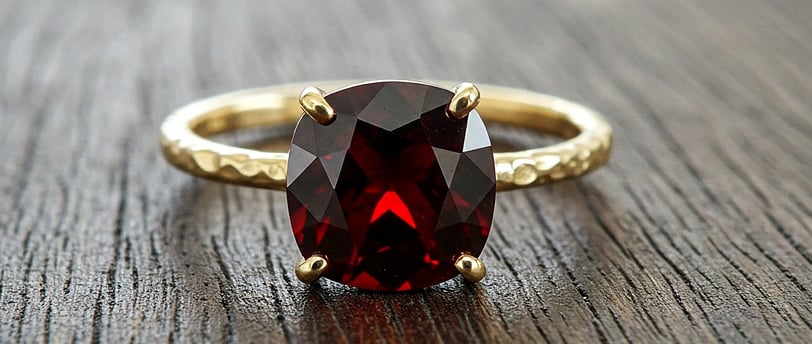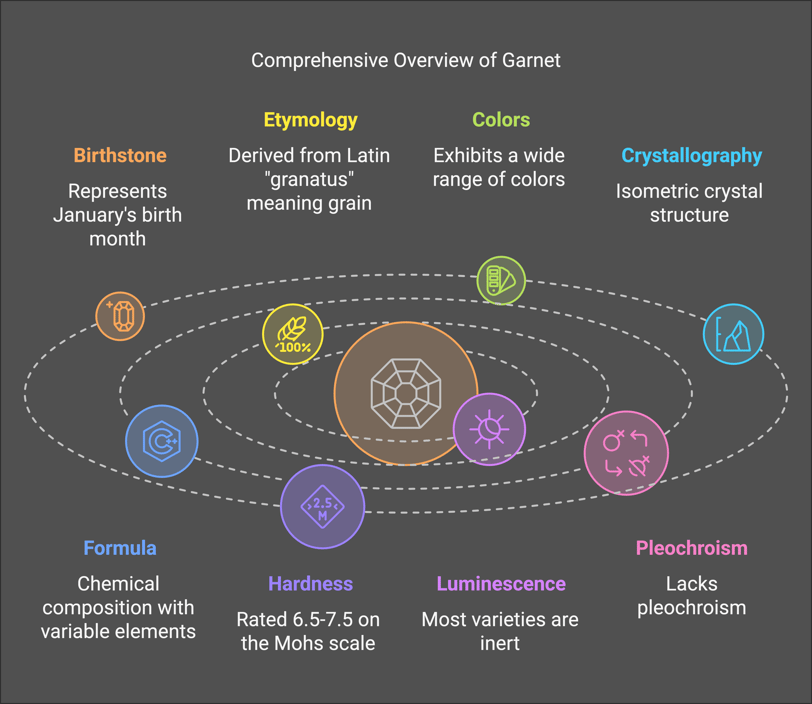Garnet
Garnets, with their rich history and diverse range of colours, are a fascinating group of gemstones. This guide delves into the world of garnets, exploring their history, origins, quality factors, and care.
1/30/20253 min read


History
Garnets have a long and storied past, with evidence of their use dating back to the Nile Delta in 3100 BC. Egyptian artisans crafted garnet into beads and jewellery. The name "garnet" comes from the Greek word "granatum", which reminded the ancients of the ruby-red seeds of the pomegranate. In earlier times, garnets were thought to light up the night, protect against nightmares, and safeguard travellers on their journeys. Today, garnets are admired globally for their vibrant colours and brilliance, gracing a wide variety of jewellery. Garnets are the birthstone for January and the gem for the second wedding anniversary.
Mineral Origins
Garnets are not a single mineral but rather a group of closely related minerals. These minerals include almandine, pyrope, grossular, spessartite, andradite, and uvarovite. Garnets are found in almost every corner of the earth, with specific colour variations depending on the region. The most common type is the red garnet, but they are also found in many other colours. Spessartine and hessonite garnets, which are orange and brown, are sourced from Namibia and Sri Lanka. The vibrant green demantoid garnet was first discovered in Russia's Ural Mountains. Tsavorite, a grass-green grossular garnet, is mined in East Africa.
The 4 C’s
Like other gemstones, the quality of a garnet is assessed using the 4 Cs: colour, clarity, carat, and cut.
Colour
Garnets come in a wide array of colours, including red, orange, yellow, green, pink, purple, and even black and colourless. Red garnets, often a blend of pyrope and almandine, are the most common. Orange garnets, such as spessartites, especially the mandarin variety, are highly sought after. Green garnets, including demantoid and tsavorite, are rare and prized. Tsavorite often shows emerald hues, while demantoid has a high dispersion but often exhibits undesirable yellow hues. Some garnets exhibit colour change properties, appearing one colour in daylight and another in artificial light. Colour is generally the most important quality factor for garnets.
Clarity
The clarity of a garnet depends on the specific type. Red garnets, such as almandine, pyrope, and rhodolite, are typically eye-clean, meaning they don't have visible inclusions. Orange garnets, like spessartine and hessonite, often have visible inclusions. Demantoid garnets frequently contain "horsetail" inclusions, which are considered beautiful and unique. Some garnets may also have inclusions that form a cat's eye or star effect, but these are very rare.
Carat
Garnets come in various sizes. Some varieties, such as demantoid and tsavorite, are rare in larger sizes, leading to a significant price increase per carat. Almandine garnets, on the other hand, are common in larger sizes, and their price per carat does not increase dramatically with size. Uvarovite is also extremely rare in facetable sizes.
Cut
Many garnets are cut into standard shapes and sizes for easy setting in jewellery. More expensive garnets, like tsavorite, are cut to retain more of their weight from the rough. The cut is very important to ensure the stone has brilliance, reflecting light evenly across the entire gem. Andradite garnets may be cut to feature their horsetail inclusions, while cleaner stones will be cut to showcase their dispersion.
Be Aware Of
Enhancements
Garnet enhancements and treatments are not common, and few garnets benefit from such processes. Most red garnets are rich in iron and can develop a metallic crust after heat treatment, although this is not usually desired by collectors. Demantoid garnets sometimes undergo a low-temperature heat treatment to reduce brown hues. This treatment is undetectable and creates a stable colour.
Simulants
Some synthetic gemstones are used to imitate garnets, but this is rare as many garnets are affordable. Colour-change glass can be used to simulate colour-change garnets. An unscrupulous dealer was once found to have sold colour change glass as natural garnet.
Synthetics
Synthetic garnets, such as yttrium aluminium garnet (YAG) and gadolinium gallium garnet (GGG), are often used as simulants for other gemstones. YAG is a poor substitute for diamond due to its low refractive index (RI), while GGG has a higher RI and makes a better diamond simulant. However, cubic zirconia (CZ) has largely replaced GGG as a diamond look-alike due to its lower cost.
Final Thoughts
Buying Tips
When buying garnets, it is best to see a variety of them to appreciate their wide range of colours. Consider unusual colours, as they can offer good value. Do not compromise on the cut, as this affects the brilliance of the gem. If you are making a significant purchase, consider getting a lab report.
Jewellery Care
Garnets range in hardness from 6.5 to 7.5, making them generally easy to care for. Stones with a hardness of 7 or higher are suitable for daily wear, as they are not easily scratched by household dust. Those with a hardness below 7 are more susceptible to scratching and are not recommended for everyday wear. To clean garnet jewellery, use warm, soapy water and a soft brush. Do not leave the jewellery submerged in water for longer than overnight.


Gemius Stones
Expertise
© 2025. All rights reserved.
